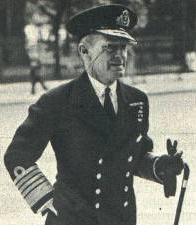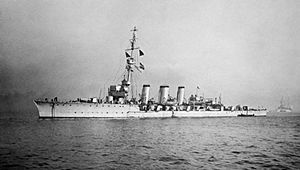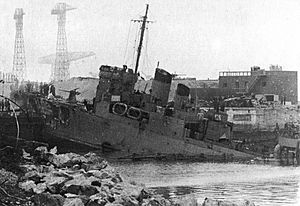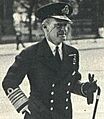Charles Forbes (Royal Navy officer) facts for kids
Quick facts for kids
Sir Charles Forbes
|
|
|---|---|

Admiral of the Fleet Sir Charles Forbes
|
|
| Born | 22 November 1880 Colombo, Ceylon |
| Died | 28 August 1960 (aged 79) Queen Alexandra Military Hospital, London |
| Allegiance | United Kingdom |
| Service/ |
Royal Navy |
| Years of service | 1894–1943 |
| Rank | Admiral of the Fleet |
| Commands held | Plymouth Command Home Fleet 1st Battle Squadron HMS Iron Duke HMS Queen Elizabeth HMS Galatea |
| Battles/wars | First World War |
| Awards | Knight Grand Cross of the Order of the Bath Distinguished Service Order Order of Saint Stanislaus, 2nd Class with Swords (Russia) Legion of Honour (France) |
Sir Charles Morton Forbes (born November 22, 1880 – died August 28, 1960) was a very important officer in the Royal Navy. He became an Admiral of the Fleet, which is the highest rank in the British Navy.
He fought in the First World War, taking part in the Dardanelles campaign and the Battle of Jutland. After the war, he was present when the German fleet surrendered. During the Second World War, he was the Commander-in-Chief of the Home Fleet. His fleet faced tough times, especially during the Norwegian campaign in 1940, where they lost ships like the aircraft carrier HMS Glorious.
Later, he became the Commander-in-Chief at Plymouth. In this role, he helped defend Plymouth from air attacks. He also planned attacks on enemy ships along the French coast, including the famous St Nazaire Raid in March 1942. He retired from the Navy in August 1943.
Contents
Charles Forbes was born in Colombo, Ceylon (now Sri Lanka). His father was a tea broker. Charles went to Dollar Academy and Eastman's Royal Naval Academy before joining the Navy.
He started his training on the ship HMS Britannia in July 1894. He quickly moved up the ranks. By January 1901, he was a Lieutenant. He served on several battleships and cruisers in different parts of the world, including the Mediterranean Sea and the Pacific Ocean.
Forbes was very good at gunnery (using ship cannons). He attended special gunnery schools and became a gunnery officer on several ships. In December 1912, he was promoted to commander.
First World War Service
During the First World War, Charles Forbes served as an Executive Officer on the battleship HMS Queen Elizabeth. He was involved in the Dardanelles campaign in April 1915.
Later, he became a Flag Commander for Admiral Sir John Jellicoe, who led the Grand Fleet. He fought in the huge Battle of Jutland in May 1916. For his bravery in this battle, he received the Distinguished Service Order. He also received an award from Russia, the Order of Saint Stanislaus.
In June 1917, he was promoted to Captain. He took command of the cruiser HMS Galatea. He was on this ship when the German fleet surrendered in November 1918.
Between the World Wars
After the First World War, Forbes continued to serve in important roles. He worked on naval ordnance (weapons) and attended advanced training courses.
He was promoted to rear admiral in October 1928. He commanded destroyer fleets in the Mediterranean. In March 1932, he became the Third Sea Lord, a very senior position in the Navy. This role involved managing the Navy's equipment and ships.
In January 1933, he became a vice admiral. He commanded the 1st Battle Squadron in the Mediterranean. When the Second Italo-Ethiopian War started in 1935, he moved his fleet to Alexandria to keep them safe from the Italian Navy. In August 1936, he became a full admiral. By April 1938, he was made Commander-in-Chief of the Home Fleet, the main fleet defending Britain.
Second World War Service
When the Second World War began, Forbes was still leading the Home Fleet. His flagship was the battleship HMS Rodney.
His fleet faced a very difficult time during the Norwegian campaign in Spring 1940. They suffered heavy losses, including the aircraft carrier HMS Glorious and nine destroyers. On April 9, 1940, his ship, Rodney, was hit by a large bomb during an air attack.
In May 1940, he was promoted to Admiral of the Fleet, the highest rank. In July 1940, he received the Knight Grand Cross of the Order of the Bath, a very high honor.
In May 1941, he became the Commander-in-Chief, Plymouth. He was responsible for defending the city of Plymouth from air raids. He also planned attacks on enemy ships in French ports like Brest. He was the one who started the idea for the daring St Nazaire Raid in March 1942, where British forces attacked a German naval base.
Retirement and Later Life
Sir Charles Forbes retired from the Navy in August 1943. After his retirement, he enjoyed playing golf. He lived in Surrey, England.
He attended important national events, such as the funeral of King George VI in February 1952 and the coronation of Queen Elizabeth II in June 1953. He passed away in London on August 28, 1960.
Family Life
In 1909, Charles Forbes married Agnes Millicent Ewen. They had a son and a daughter together. After his first wife passed away, he married Marie Louise Berndtson in 1921. They had one daughter, Elizabeth Forbes, who became a well-known music critic and author. His younger brother, Oswald Boyd Forbes, was a Colonel in the military.
Images for kids




